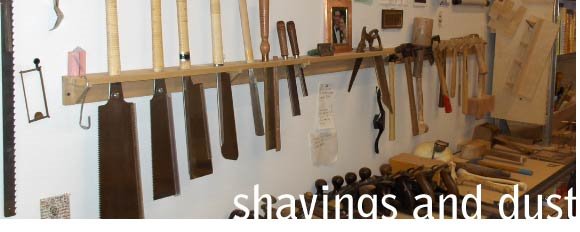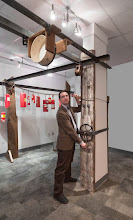the proprietress of Waypoints wrote about artists operating at a remove, and it got me to thinking again about my relationship to the material I use and how I work. She was writing about the conductor’s remove from the music, in the sense that the conductor uses musicians who use instruments to make the music, and that there is a remove there that is not present for, say, a writer, who crafts words directly to give shape to thought.
What we are talking about, of course, is what filters we use to touch the divine, What lenses we employ to refract capital-T Truth, to portray capital-B beauty in a meaningful and honest way.
This conversation bubbles up frequently in the woodworking world as the conversation about dovetails. It is a conversation about the relevance of what is referred to as “hand work” in a machine age. One camp says that it is more honest and pure to use traditional hand tools and to lay out and cut the dovetails one by one, the implication being that because the tools are not plugged in they are more honest, more direct, and that they speak more about craftsmanship. The other camp says that the tools used are irrelevant , that as long as the end product fits tightly the methodologies used to produce it shouldn’t be questioned.
Both camps are right, of course.
The underlying question that is relevant to what Cheyenna was writing about is the question of operating at a remove from our work. How many tools have to be involved before the integrity of the work is compromised? If I use a table saw (which was invented in the 1850’s by a Shaker woman) am I at more of a remove from my work than if I write with a ball point pen (first patented in 1888)? How about if I use a computer to write, which is a device that is not only so complicated that I have no idea at all how it works, it stores the words I write in a way that without another computer they can not be accessed at all? If I cut my dovetails with using a marking gauge, a bevel gauge, a handsaw and a chisel, am I closer to the work than if I use a routing jig and an electric router? The electric methodology actually requires fewer tools, but is typically seen as being less “pure” somehow (especially by me).
This question of being at a remove, of operating from a distance, is central in my own studio work. The more we are aware of the origins of the things we make and their place in the “enormous long river” of history, the more thoughtful we can be about our own place in the same river. But it is interesting to me how selective I tend to be when choosing in which arenas I can be distant and in which I must be directly involved in all steps.
When I use a guitar to play notes and sing words that some one else wrote I do not feel at all that I am operating at a remove from the beauty of the song. Nor do I feel that I am not somehow making the song. In fact the sense of ownership over singing that song as beautifully as possible in that moment is incredibly raw, and comrades joining in the moment are bound very closely to me as the singer and musician, with them as fellow makers in a very real and relevant way. The fact that none of the craft involved is necessarily mine, that I neither wrote the music or the words, nor made the guitar, does not diminish at all the profundity of the moment nor my sense of ownership of and participation in it.
What, then, makes using non-electric (“olde-timey”) tools allow me to feel closer to my work? What is more “honest” about having to think about every saw stroke than about having to be thoughtful about how I set up a routing jig to make routed dovetails?
Part of it is that it is easier for me to connect to craftspeople that have come before me if I use the tools that they used. This is a limited view, though, as it is thinking about making in a physical sense only. Consider instead the modern cabinet maker whose livelihood is cranking out cabinets: This is a craftsman that has a clear and present need to produce as many cabinets as possible in as short a time possible, which connects him philosophically and practically to his forbears in a pretty direct way, which not only necessitates using power tools, it encourages it. My romantic attitudes about craft and its place in society is actually divergent from the day to day thought processes of the very craftspeople in the 19th century that I wax so lyrical about.
Yet again, we are at an impasse. What it comes down to is value systems, and about continuums of honesty and where we make a stand relative to where others make a stand. And the landscape on which we make that stand is constantly shifting, making it hard to plant a flag anywhere with absolute conviction.
What is important as an outcome of this rather circular thought process is that as makers we have an obligation to continue to be thoughtful about what we make and how we make it. Though these are questions without answers, they are important as questions, and the act of constant questioning is what, in the end, makes possible the most relevant making.


No comments:
Post a Comment